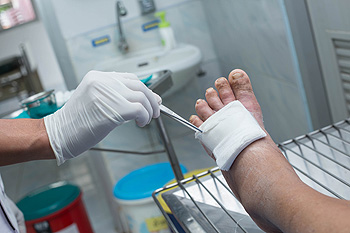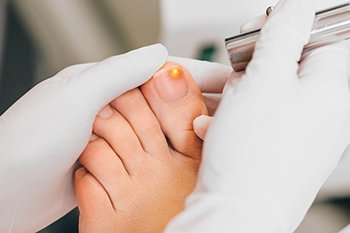Connect With Us
Blog
Items filtered by date: November 2023
The Importance of Treatment for Diabetic Foot Ulcers

Diabetes can harm the nerves and blood vessels in your feet, reducing your ability to feel injuries. Minor foot problems like calluses, blisters, or cracks can develop into serious foot ulcers, often on the ball of the foot or under the big toe. These ulcers can become infected and lead to gangrene, potentially requiring the amputation of toes, parts of the foot, or even the leg. If you have a foot ulcer, it is vital to keep weight off the affected area to aid healing. For diabetics, early treatment of foot issues is crucial to prevent them from worsening. If you have diabetes, it is strongly suggested that you make routine appointments with a podiatrist to make sure your foot health is properly managed.
Wound care is an important part in dealing with diabetes. If you have diabetes and a foot wound or would like more information about wound care for diabetics, consult with Jeffrey L. Bober, DPM from Maryland. Our doctor will assess your condition and provide you with quality foot and ankle treatment.
What Is Wound Care?
Wound care is the practice of taking proper care of a wound. This can range from the smallest to the largest of wounds. While everyone can benefit from proper wound care, it is much more important for diabetics. Diabetics often suffer from poor blood circulation which causes wounds to heal much slower than they would in a non-diabetic.
What Is the Importance of Wound Care?
While it may not seem apparent with small ulcers on the foot, for diabetics, any size ulcer can become infected. Diabetics often also suffer from neuropathy, or nerve loss. This means they might not even feel when they have an ulcer on their foot. If the wound becomes severely infected, amputation may be necessary. Therefore, it is of the upmost importance to properly care for any and all foot wounds.
How to Care for Wounds
The best way to care for foot wounds is to prevent them. For diabetics, this means daily inspections of the feet for any signs of abnormalities or ulcers. It is also recommended to see a podiatrist several times a year for a foot inspection. If you do have an ulcer, run the wound under water to clear dirt from the wound; then apply antibiotic ointment to the wound and cover with a bandage. Bandages should be changed daily and keeping pressure off the wound is smart. It is advised to see a podiatrist, who can keep an eye on it.
If you have any questions, please feel free to contact our office located in Glen Burnie, MD . We offer the newest diagnostic and treatment technologies for all your foot care needs.
Laser Treatment for Fungal Toenails

Fungal nail infections, medically known as onychomycosis, can be stubborn and challenging to treat. Traditional methods consisting of topical antifungal creams or oral medications may not always provide the desired results. In such cases, laser treatment for fungal nails has emerged as an alternative solution. Laser treatment, often referred to as laser therapy or laser fungal nail treatment, is a non-invasive procedure designed to target and eradicate the fungal infection in toenails or fingernails. During the procedure, a specialized laser emits a focused beam of light, which generates heat that penetrates the infected nail and the underlying fungal structures. This controlled heat effectively kills the fungus without causing damage to surrounding tissues. Laser treatment for fungal nails is considered a safe and efficient option, particularly for individuals who are reluctant to use or cannot tolerate traditional medications. If you have developed toenail fungus, it is suggested that you schedule an appointment with a podiatrist who can determine if laser treatment is right for you.
Laser treatment can be an effective way to get rid of toenail fungus. If you have any questions about laser treatment, consult with Jeffrey L. Bober, DPM from Maryland. Our doctor will assess your condition and provide you with quality treatment for fungal nails.
What Are Toenail Fungal Infections?
Onychomycosis, or fungal infection of the nail, is a relatively common and non-serious condition. Around 10 percent of U.S. citizens are afflicted with fungal nails. Common forms of fungus that infect the nail include dermatophytes, yeasts, and molds.
Symptoms of Toenail Fungal Infections Include:
- Nail thickening
- Brittleness of the nail
- Discoloration of the nail
Diagnosis for Fungal Nails
Fungal infections are diagnosed by fungal culture and microscopy. This will rule out any other conditions such as nail trauma, psoriasis, lichen planus, and onychogryphosis.
What Is Laser Treatment?
Laser treatment is a non-invasive, safe, quick, and painless procedure that uses the heat from a laser to kill fungus in the nail. Each infected nail is targeted with a laser for several minutes. The treatment is usually utilized several different times over a select period. During this time, a podiatrist will keep an eye on the infection.
If you have any questions, please feel free to contact our office located in Glen Burnie, MD . We offer the newest diagnostic and treatment technologies for all your foot care needs.
Causes and Symptoms of Foot Stress Fractures

Stress fractures, those tiny cracks in the bones of the feet, are a common concern for athletes, dancers, and anyone who spends a significant amount of time on their feet. These fractures are usually a result of repetitive stress and overuse, rather than sudden trauma. One primary cause of stress fractures is overexertion, often seen in athletes who increase their training intensity too quickly. Wearing Improper footwear or a sudden change in physical activity can also put undue stress on the bones. Inadequate nutrition and underlying conditions such as osteoporosis may weaken bones, making them more susceptible to fractures. Symptoms of a stress fracture typically include localized pain, swelling, and tenderness in the affected area. The pain usually worsens with activity and eases with rest. Left untreated, stress fractures can progress to chronic pain and complications, so early intervention is essential. Understanding the causes and recognizing these symptoms allows for prompt diagnosis and proper care, reducing the risk of more severe injuries and ensuring a quicker return to an active, pain-free lifestyle. If you have developed a foot stress fracture, it is suggested that you visit a podiatrist as quickly as possible who can effectively treat this condition.
Activities where too much pressure is put on the feet can cause stress fractures. To learn more, contact Jeffrey L. Bober, DPM from Maryland. Our doctor can provide the care you need to keep your pain free and on your feet.
Dealing with Stress Fractures of the Foot and Ankle
Stress fractures occur in the foot and ankle when muscles in these areas weaken from too much or too little use. The feet and ankles then lose support when walking or running from the impact of the ground. Since there is no protection, the bones receive the full impact of each step. Stress on the feet can cause cracks to form in the bones, thus creating stress fractures.
What Are Stress Fractures?
Stress fractures occur frequently in individuals whose daily activities cause great impact on the feet and ankles. Stress factors are most common among:
- Runners
- People affected with Osteoporosis
- Tennis or basketball players
- Gymnasts
- High impact workouts
Symptoms
Pain from the fractures occur in the area of the fractures and can be constant or intermittent. It will often cause sharp or dull pain with swelling and tenderness. Engaging in any kind of activity which involves high impact will aggravate pain.
If you have any questions please feel free to contact our office located in Glen Burnie, MD . We offer the newest diagnostic and treatment technologies for all your foot and ankle needs.
Surgery May Relieve Painful Corns

Corns on the feet are most commonly caused by excessive pressure on the toe or bottom of the foot from wearing tight or ill-fitting shoes. When painful corns on your feet become unbearable and conservative treatments no longer work, surgery is a viable option. Corns, known medically as heloma, can become excruciating, making even the simplest daily activities a painful ordeal. The surgical procedure involves making a small incision over the affected toe to access the corn. The foot doctor removes the corn, repairs any tendon that may be involved, and closes the incision. Various numbing options, including general anesthesia, a spinal block, or local anesthesia with sedation, are offered based on the severity of the procedure. Surgery for painful corns addresses the root causes of discomfort and can provide a permanent solution. If persistent corn-related pain affects your life, it is suggested that you make an appointment with a podiatrist. This foot doctor can assess the need for surgery or offer other treatment options as needed.
If you have any concerns regarding your feet and ankles, contact Jeffrey L. Bober, DPM of Maryland. Our doctor will treat your foot and ankle needs.
Corns: What Are They? and How Do You Get Rid of Them?
Corns can be described as areas of the skin that have thickened to the point of becoming painful or irritating. They are often layers and layers of the skin that have become dry and rough, and are normally smaller than calluses.
Ways to Prevent Corns
There are many ways to get rid of painful corns such as wearing:
- Well-fitting socks
- Comfortable shoes that are not tight around your foot
- Shoes that offer support
Treating Corns
Treatment of corns involves removing the dead skin that has built up in the specific area of the foot. Consult with Our doctor to determine the best treatment option for your case of corns.
If you have any questions please feel free to contact our office located in Glen Burnie, MD . We offer the newest diagnostic and treatment technologies for all your foot and ankle needs.
Are You Suffering From Nerve Damage?
Blog Archives
- April 2025
- March 2025
- February 2025
- January 2025
- December 2024
- November 2024
- October 2024
- September 2024
- August 2024
- July 2024
- June 2024
- May 2024
- April 2024
- March 2024
- February 2024
- January 2024
- December 2023
- November 2023
- October 2023
- September 2023
- August 2023
- July 2023
- June 2023
- May 2023
- April 2023
- March 2023
- February 2023
- January 2023
- December 2022
- November 2022
- October 2022
- September 2022
- August 2022
- July 2022
- June 2022
- May 2022
- April 2022
- March 2022
- February 2022
- January 2022
- December 2021
- November 2021
- October 2021
- September 2021

